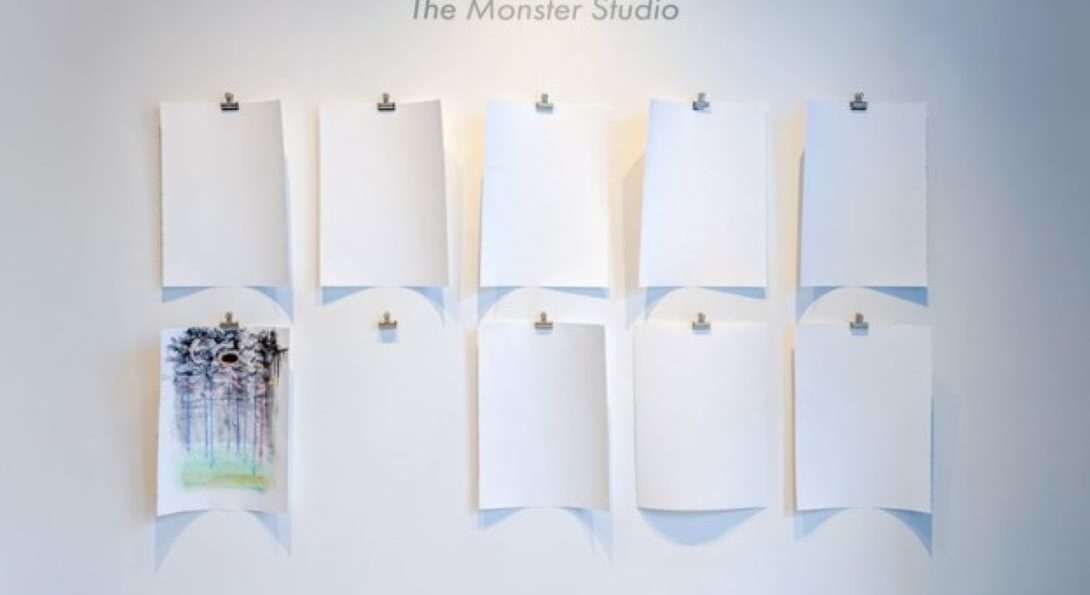Riva Lehrer’s solo show, The Monster Studio, at Zolla Lieberman Gallery

Introduction
On September 6, 2024, Riva Lehrer’s solo show entitled, The Monster Studio opened at Zolla Lieberman Gallery. The show will be open until October 12. Twisting the concept of the gaze, as I looked at each of Lehrer’s pieces, they looked back at me. “The gaze” alludes to how historically men have looked at women in art and turned them into objects. Through her portraits, Lehrer questions what the gaze means for disabled bodies. We are taught not to stare at disabled bodies for too long. But, what does it mean when they look right back at us and turn their stare on to the starer?
In her statement of purpose, Lehrer states, “Trying to take agency in the world can be a difficult, even disturbing experience. It can easily entail decisions that make one feel like a monster. That said, this is not necessarily a negative. A monster can be an agent of damage, certainly, but it can also be an avatar of ferocity and drive.” Through her work, Lehrer artistically reclaims “monster.” As seen in the documentary Code of the Freaks, in which Riva Lehrer was a participant, filmmakers and our culture at large have long portrayed disabled people as monsters and conversely monsters as disabled people. In The Monster Studio, a monster is more than a creature people fear. A monster is an agent of change, activism, and self reclamation. It takes “ferocity” and “drive” to make effective, societal change, and that change does not come easily. It can involve struggles, anxieties, harm and missteps. Oftentimes, when learning about past positive action, we gloss over the harsh realities of public action. Lehrer refuses to do so. Just as she exposes our constant stares, Lehrer reveals imperfections whether as she writes, it is “a dot, a color, a pile of torn paper, a rain of teeth.”
As a portrait artist, Lehrer takes on the role of shapeshifter. I am a disabled artist myself and I met up with some fellow School of the Art Institute of Chicago MFA graduates at Lehrer’s opening. One of them commented that there were so many different portrait artists in the show. Even though I have been familiar with Lehrer’s work for years, as I explained to my friend that all the work was in fact Lehrer’s, I started to doubt myself a little. The work ranges from realistic, almost ethnographic, graphite drawings of animals with medical supplies to small acrylic paintings of characters from Buffy the Vampire Slayer, to mixed media portraits ranging in style, and to a small art studio set up in the corner. Lehrer uses fiber art techniques, traditional painting and drawing techniques, and her own style to create a large breadth of portraits of fellow disabled activists, artists, and monsters of change.
Beyond subject matter, what links all of Lehrer’s work in The Monster Studio together, to me, is her specific style of rendering faces. Her subjects are easy to recognize and not just because they are labeled in a packet on the gallery’s front desk. Lehrer’s style includes a certain level of realism. Yet, through a multimedia and collaborative approach with her subjects, that realism is often slightly distorted with fantastical elements such as the collaged net of medical entanglements in Lehrer’s portrait of Stephanie Kielb, MD. Also importantly, subjects of Lehrer’s artwork are not subjects at all. Instead, Lehrer and the people in her portraits are collaborators. They work together to create each piece. Instead of drawing a face, Lehrer represents a full person whom she gets to know personally and together, they assume mutual risk. Lehrer recognizes the vulnerability behind being in a portrait and allows herself to be vulnerable too. In an act of interdependence, Lehrer included pieces of her own medical records and a small portrait of herself in her portrait of Stephanie Kielb, MD. Interdependence comes from disability justice and includes meeting each other’s needs collectively rather than independently. It is a call to collective action and to leaning on each other in order to create access.
Beyond showing her finished work, The Monster Studio includes a six week long public portrait studio. Most artists work in private spaces so I am excited to see how the public nature of Lehrer’s portrait studio will impact her as a person and as an artist. Lehrer sees this process as turning her art practice “inside-out.” An art practice includes both an artist’s body of work and how they make it. In her own words, “Rather than focusing on the ways in which we are formed by society, I am asking how we affect the world.” In many ways, Riva Lehrer is asking all of us what our inner monster can do.
Libby Evan is a disabled artist, researcher, and activist. Originally from Albany, NY, she now resides in Chicago, IL. She is currently a PhD student in Disability Studies at the University of Illinois, Chicago. In 2024, she earned her MFA in Fiber and Material Studies at the School of the Art Institute of Chicago. She holds a BFA in studio art from Washington University in St. Louis, The Sam Fox School of Design and Visual Arts. Evan’s research and art practice focuses on her experiences of having invisible disabilities as she breaks down the facade of being okay on the outside but not so much on the inside. Her work is currently on view in Voices Embodied V at the Design Museum of Chicago until October 13.
@libbyevanart